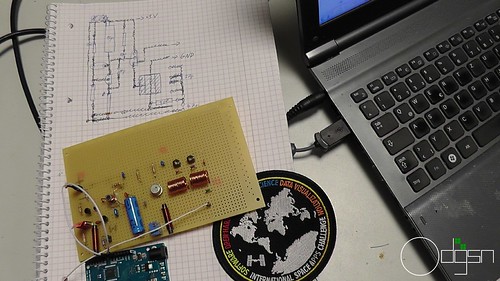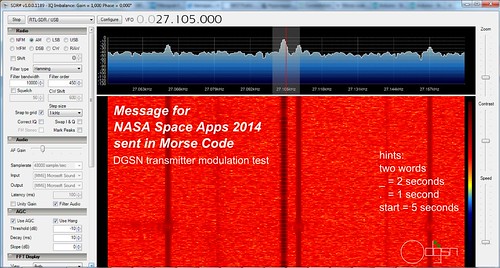you-are-welcome
This project is solving the Virtual Ground Station App – Global Crowdsourcing of CubeSats challenge. Description
You are WelCOMe! (Distributed Ground Station Network)
Small satellite missions face two special challenges due to limited financial budgets. The first is tracking the satellite for orbit determination after orbit injection. The orbit can vary from the specified orbit when the satellite will be launched as secondary or parasitic payload. In case of unknown orbit parameters high-gain antennas cannot be pointed towards the satellite and establish the first connection needed for satellite activation. The second challenge is to transmit all housekeeping and scientific data to mission operations via a limited number of ground-stations.

The Distributed Ground Station Network (DGSN) solution can solve the problem with permanent tracking and a faster orbital element provision to the satellite owners. And it can provide permanent reception of satellite signals with its data-dump mode in between main ground-stations provided by the satellite owner. The key feature is the network of small ground-stations placed globally connected via the internet and performing an automatic scan of satellite (and other beacon) signals, storing and sending them back to a central server, where they can be accessed by the satellite owner. With a correlation of the beacon signal and GNSS synched ground-station time the satellite position is determined with pseudo-ranging trilateration.
The DGSN project was started in 2012 as a community and open-source project (youtube video explaining DGSN in 3 minutes). The essential feature for this project is the beacon signal event detection and reception time correlation, which allows the pseudo-ranging calculation. As an open-source project, tracking satellite is the long term goal, which requires evaluation of the hardware as well as the software on ground before it will be able to generate accurate results for space-borne signals. For this small work packages are created, and the design of a simple and deterministic behaving pair of transmitter and receiver modules are worked on.
Due to the fact that the overall concept of DGSN has been started before (together with Hackerspace Global Grid) and a project of this scale cannot be fully worked on during 3 days of hack-a-thon, we chose this smaller work package for spaceapps, because the expected time to sketch, design and build a first prototype of the transmitter was expected to be possible for two people via virtual participation during one weekend. This endeavor is called "You are WelCOMe!" and is intended to make us and other people understand how RF transmission works and give them an easy DIY tutorial! End in the long run, it shall be be used for evaluating the position and tracking algorithms for tracking cubesats with the Distributed Ground Station Network. Or to have some fun by hijacking and controlling your neighbour's rc toy car (which remote control is also working on this frequency band)
If you are interested to review the design and want to help to improve it, send us an email to [email protected]
Wrapped up
What we did
- in advance, we already work on DGSN, so we choose a small work package suitable for Space Apps
- took a book [Mastering Electronics by John WATSON, ISBN 0-333-66970-3]
- discussed what the RF modules need to do and specified the requirements (analog and discrete ICs for deterministic transmission)
- discussed some more the circuitry, because some in Mastering Electronics didn't work on the breadboard; We changed some configuration.
- designed a first layout for the transmitter and receiver on a sheet of paper, and made a parts list (see GitHub)
- went to the local electronics store to buy them, and the rest was found in our hackerspace shackspace
- soldering it on a prototype board
- testing the circuitry and checked range with SDR and CB-radio on that frequency
- finished soldering
- coded the Morse code programme for Arduino, which modulated the transmitter
- made some tests with it (see twitter image we sent to @spaceapps via our @ardnnews)
- tried to figure out how to tweak the design [for example added an adjustable resistor at the power transistor in the transmitter design]
- repeated the design, soldering and testing
- started to build the receiver the same way we did for the transmitter. This was finished 95% and testing for the circuitry began
- wrapping up the hack, by documenting the circuit diagram and commenting to it (see GitHub), adding all files to GitHub.
- partying afterwards

Results (Pro and Con)
Some of our findings and observations
- transmitter modulation works. Morse code is working and visible
- +-4 V out of 9 V of source voltage at the antenna
- on breadboard 25 m of range tested with SDR. After soldering only 5 meters of range
- deterministic behaviour seems to be there. We measured signal run times with about +-1 clock (at 40 MHz) by an external timing board we have
- receiver does the mixing of frequencies and adds and subtracts the frequencies (27.105 MHZ and 26.65 MHz) to 455 kHz
- power level at jfet seems okay for incoming signal via antenna, mixing is okay. After first transistor the amplification seems not to work. DO WE HAVE TO PULL IT UP to 0.7V? (we stopped here, it needs further investigation!)

Perspectives
It seems to work, but we need your help to improve the range. Contact us if you know what did right and wrong! That is the power up Open-Source and SpaceApps! We will keep working on it anyway. DGSN is part of this year's Google Summer of Code 2014 and it will start 21. April. We will also put the software as well as hardware under open-source licenses. So spaceapps was a good warm-up for us and the community. Let's track some cubesats!
Thank you SpaceApps!

PS: The markdown is unfortunately not working for the lists
Project Information
License: MIT license (MIT)
Source Code/Project URL: https://github.com/aerospaceresearch/SpaceApps2014-DGSN-You-are-welCOMe
Resources
Distributed Ground Station Network (DGSN) explained (Youtube) - https://www.youtube.com/watch?v=TC4Ls3AGHf4
dgsn.aerospaceresearch.net blog - http://dgsn.aerospaceresearch.net/
Paper: Distributed Ground Station Network - a global system for tracking & communication w/ sats - http://www.slideshare.net/aerospaceresearch/iac-2013-dgsn4ccbyncsa
Lone Pseudoranger - Tracking Software Test for HGG (GitHub) - https://github.com/shackspace/hgg/tree/hornig/tracking/applications/tracking/lonepseudoranger
SDR# - Software Defined Radio in C# - http://sdrsharp.com/
Some photos of our hacking during spaceapps2014 - https://www.flickr.com/photos/[email protected]/sets/72157643860534194
The Distributed Ground Station Network (Youtube) - https://www.youtube.com/watch?v=e8KySj2wH64
Constellation as infrastructure for DGSN - http://www.aerospaceresearch.net/constellation
Hackerspace Global Grid (Community) - http://www.hgg.aero/